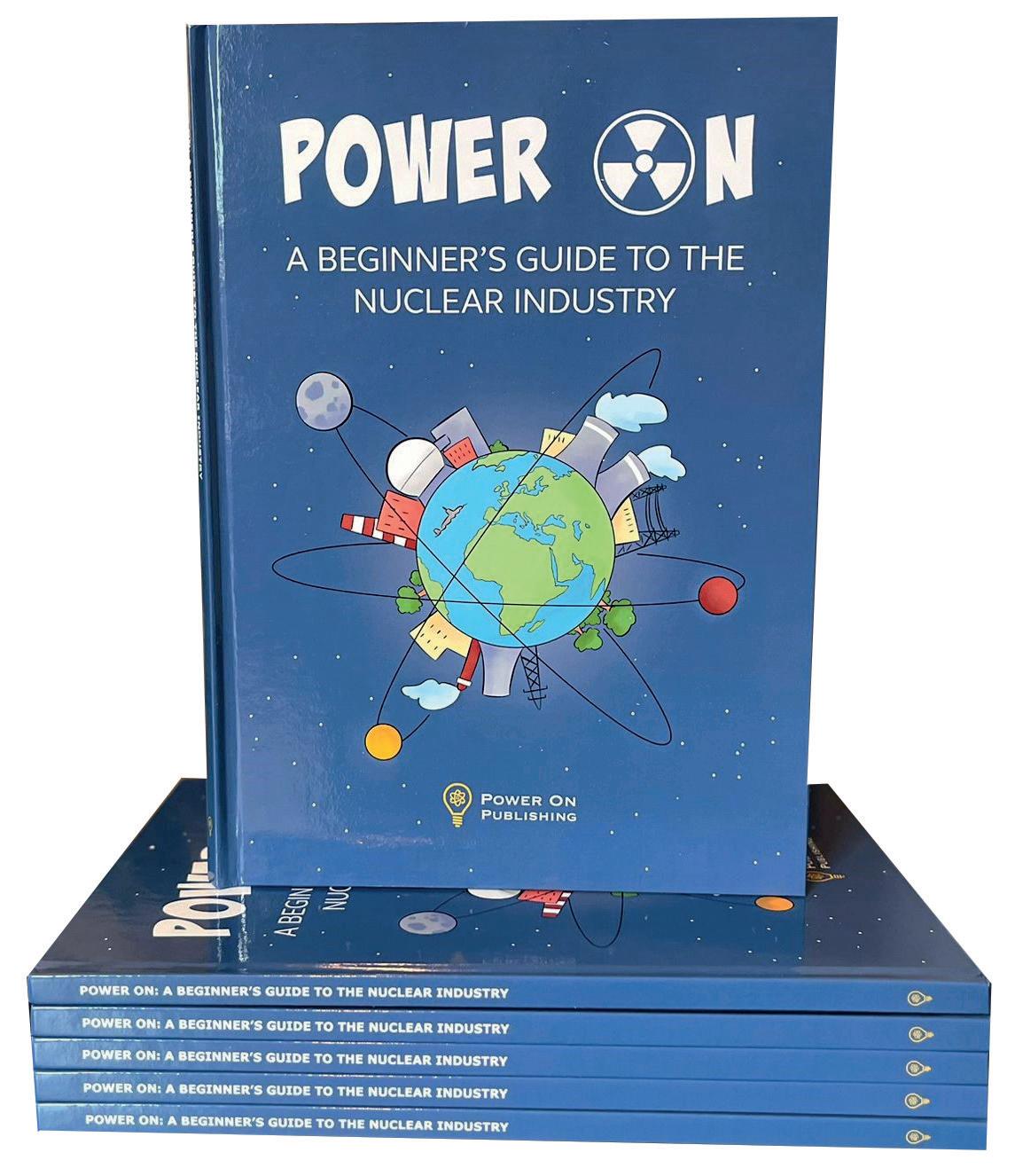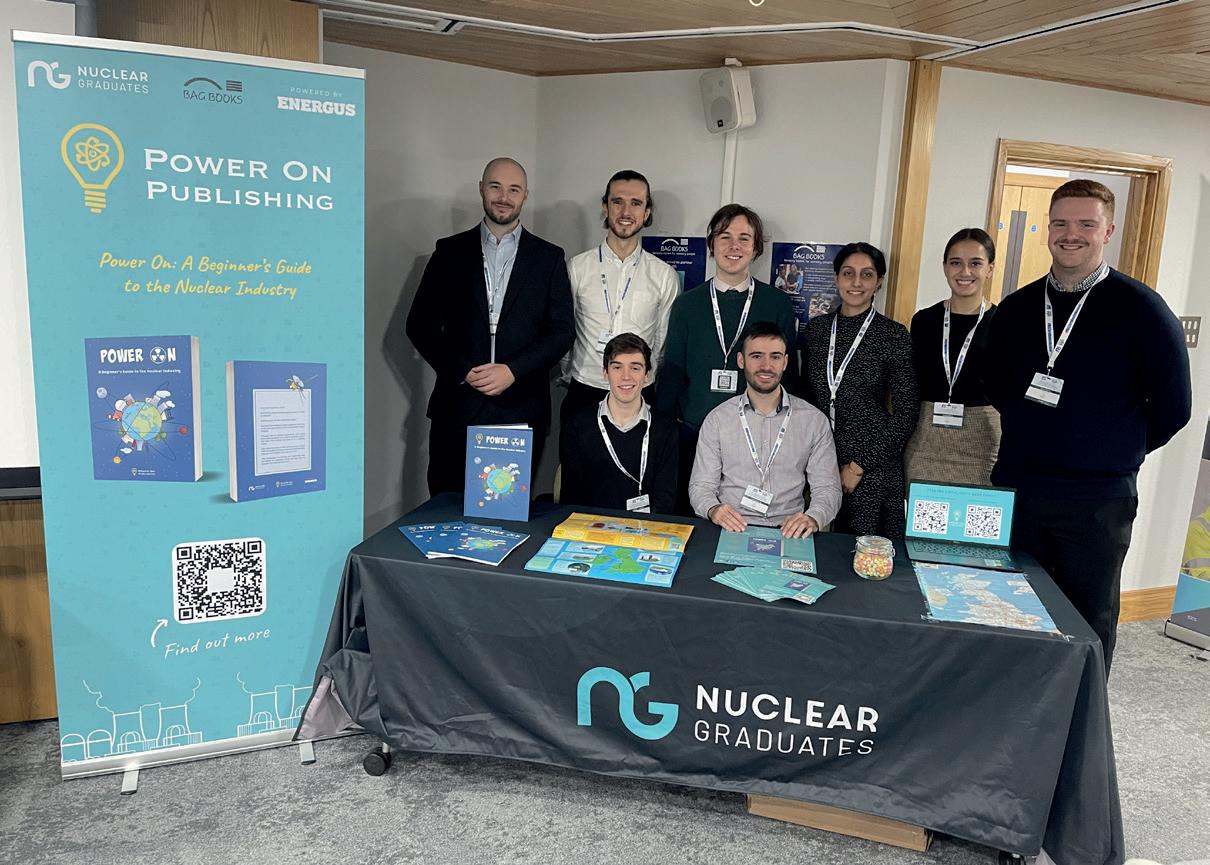
5 minute read
Powering On: The story of nuclear for the next generation
Power On Publishing is a company formed by a team of eight Nuclear Graduates in response to a key challenge facing the nuclear industry: tackling skills shortages as the industry grows to meet Net Zero targets. Together, we have written Power On: A Beginner’s Guide to the Nuclear Industry, which tells the story of the full breadth of the UK nuclear sector in an accessible way. Our goals are to challenge perceptions of nuclear and inspire young people to explore the exciting careers within the sector.
The book breaks down the tory of nuclear power, including the more complex topics into easily digestible information accompanied by brilliant illustrations, career Q&As, job profiles and interactive activities. Whilst it was initially designed with an 11–14-year-old audience in mind, complementing the ‘Energy’ topic in the KS3 National Curriculum, our first customer reviews suggest there is something in it for everyone!
Power On offers an introduction to the nuclear industry from the fundamental scientific principles related to atoms and radiation to the various stages of the nuclear fuel cycle, including electricity generation at nuclear power stations, decommissioning, and waste management. It also explores other practical applications of nuclear technologies, including emerging advancements in areas such as fusion and more!
Working as a team we made it our vision is to make a career in the nuclear industry an aspiration for the next generation, regardless of background or academic interest. For this reason, our book includes multiple career-focused sections to showcase the range of exciting career opportunities and pathways into nuclear. This includes Q&As with talented individuals working within our industry, as well as job descriptions linked to the nuclear technologies explored in the book’s pages.

Where can I find ‘Power On: A Beginner’s Guide to the Nuclear Industry’?
Our book is available to purchase via our website (scan the QR code or visit poweronpublishing.co.uk) and at any in-person events Power On Publishing attend. Please check our social media to keep up to date with the events we are heading too next!

At Power On Publishing, we are keen to collaborate with you and your organisation, and in doing so broaden the reach and impact of our book. We are flexible in our approach to partnership and are happy to work with you to fulfil your requirements. Email poweronpublishing@mail.com to find out more about opportunities in your organisation!
Power On Publishing is proud to be in partnership with Bag Books, a small charity based in South West London that creates multi-sensory stories for people with severe or profound and multiple learning difficulties. They tell their stories using emotion, voice and interactive activities rather than words. Christie from Bag Books said, “I hope that Bag Books continues to grow and thrive so that our work can benefit the lives of as many people as possible and provide inclusive opportunities to those who need us the most.”
All profits from our business will be donated to this amazing cause, ensuring it continues to thrive.
Nuclear has had a good spring. In my last column, I wrote about the urgency of the UK turning broad political support for nuclear into action. I listed six steps that we wanted to see, so let me set out the progress report here:
● Green labelling nuclear investment as sustainable: I will quote the Chancellor in his Budget speech “Subject to consultation, nuclear power will be classed as environmentally sustainable in our green taxonomy. That will give it access to the same investment incentives as renewable energy.”

● Launch of Great British Nuclear: GBN was launched this spring, as a resurrection of British Nuclear Fuels Limited, with the mandate to run a SMR down selection process this year, work with the Government on siting access, and consider the role of further large-scale nuclear, as well as the powers to form subsidiaries and joint ventures with the private sector for individual projects.
● Funding for DESNZ/GBN to get two projects to FID in the next Parliament: not committed and not ruled out
● A commitment to a programme approach to reactor deployment: let me quote again “The government is committed to a programme of new nuclear projects beyond Sizewell C, giving industry and investors the confidence they need to deliver projects at speed. The aim of GBN is to facilitate delivery of this programme of new nuclear projects.”
● Initiating negotiations on how we fund SMRs: not committed to yet.
● Planning reform, including the swift imposition of a Net Zero duty on regulators: an amendment to the Energy Bill to place a Net Zero duty on regulators passed the House of Lords, and there is an active discussion in Government about how to respond.
The Government took three of those six steps, it may take another one, and two it has not taken yet. By any measure, that is a great success for industry. We still need to see the consultation, but the green label for nuclear opens up a bigger pool of investors for our projects. A commitment to a programme suggests we have learned the lessons of past failures stopping and starting, toying and tinkering, but never repeating. The formation of Great British Nuclear, and in particular its empowerment to get involved with individual projects, augurs well.
Political pressure was the reason these steps have been taken. Our team played our part, helping to organise more than 100 Parliamentarians of all parties to write to the Prime Minister to call for the green labelling of nuclear investment and meaningful powers for GBN. The arguments we and others have made to the Chancellor, the Prime Minister and the Government as a whole that nuclear is key to a sustainable, affordable and secure energy system have been compelling. The rhetorical and in-principle policy support for nuclear now has form and structure in a way that it has not had for decades.
The key now, is to have that new structure secure projects. The keen-eyed or cynical observers among you will have noted that the two steps to which the Government did not commit shared one key word funding. That is the way we get from organisations and technologies to projects, and that has to be our absolute priority now. Within that, there are four key aspects:
● The Government should confirm as soon as possible the capital structure for the Sizewell C project, including how it will fund its own stake in the project. Only when the capital structure is set will the team know which kinds of investors to target to secure a Final Investment Decision in 2024.
● The Government should offer a meaningful prize for winning the SMR competition. The winners should get access to a site, access to a funding model (either CfD or RAB) to raise investment, and the offer of a Government minority stake to pave the way to FID.
● The Government should spell out the conditions under which it will pursue further large-scale nuclear, including if it will allow plants built outside the UK to be used as reference plants for access to the Regulated Asset Base model funding.
○ Since the beginning of 2022, a new EPR, a new APR-1400, and a new AP1000 have all started generating power. The designs have been built, and they work. It has been the best spell for Western large-scale nuclear in 20 years, and we should take advantage.
● The Government should clarify if GBN will become a nuclear site licensee and operating company, and if not, how new projects will be developed.
All of these points are about securing projects a specific reactor built on a specific site by a specific company that will be operated by another specific company. That is the task ahead of us, and the NIA will be pushing as hard as ever to secure real substantive investment in our sector. As always, if you want to be a part of making this case, let me know at lincoln.hill@niauk.org the work goes on!








